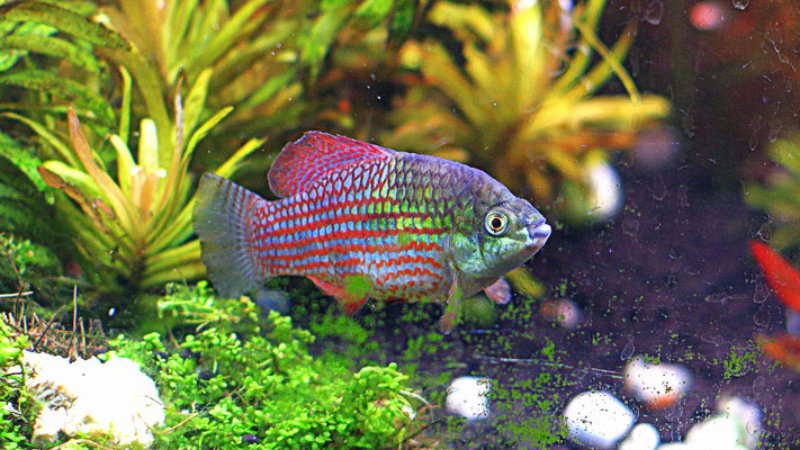How frequently do you seek new colorful fish species in order to add to your aquarium? In fact, it happens more often than we realize. Having said that, the American flagfish is among the few fish species that you want to introduce to an awesome aquarium. In this article, I will give you all the information you need to know about this interesting fish, such as its habitat, behavior, breeding, how to care for it, and more.
Description
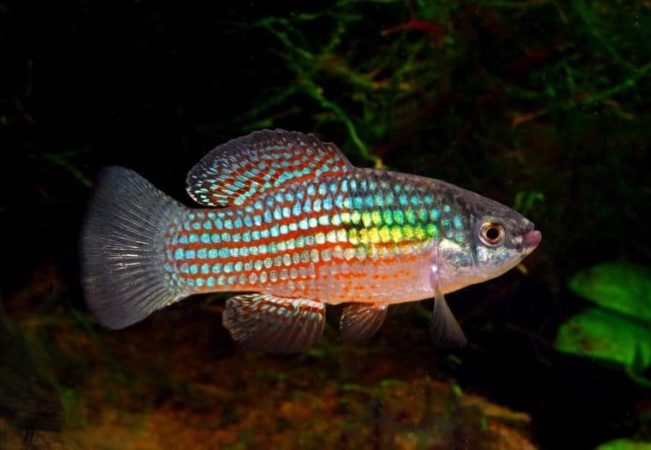
The flagfish is a small, robust fish that measures 6 centimeters (2.4 inches) in length, with a truncated snout that has been likened to a bulldog’s. Their dorsal and anal fins are located posteriorly and next to the caudal fin, giving them a rounded appearance. Their flank and dorsal fin are well marked by an opaque white border. Some individuals have reddish-colored fins, however, the cause of this is uncertain. The female’s body is mostly olive, but it is heavily adorned with turquoise scales.
When it comes to males, the term Flagfish comes from the fact that their patterning resembles the United States flag. To represent the blue and white stars of the American flag, a black rectangle appears on the shoulder, and horizontal stripes, some red and others whiter, go down the sides of the design, however, these are greenish rather than white. The lower posterior corner of the black rectangle is likewise dark in the male. Nondominant males, females, and juveniles are olive-gray in color and pattern, which is the foundation for the more colorful pattern of dominant males.
Habitat and Biology
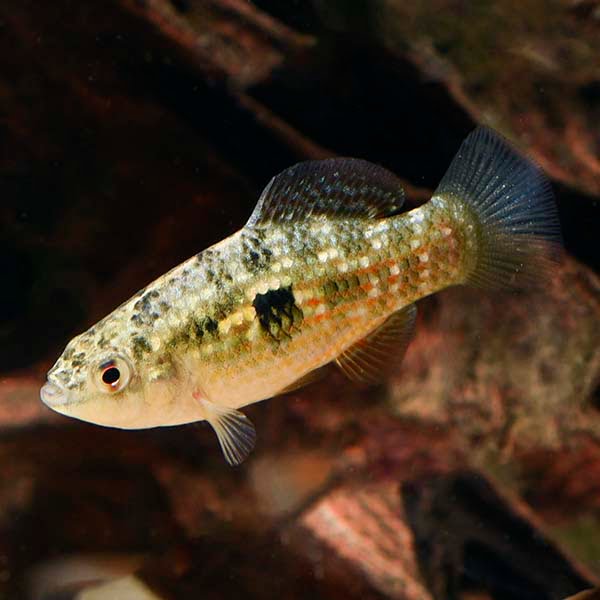
Although the flagfish is most often found in freshwater areas, it has also been found in slightly brackish water on a few occasions. This species of flagfish has been included in the Guinness Book of World Records as the smallest egg-laying fish, laying only 20 eggs over the course of a few days. It’s common for the female to nip the male as part of their wooing ritual. Afterward, the female swims backward, while the guy backflips in front of her.
As soon as the eggs are deposited, the male protects them by fighting nearby fish. The male, on the other hand, has been known to consume the eggs and young of his own species. According to some reports, this species exhibits no signs of parental affection.
This species is an omnivore, eating on tiny invertebrates and zooplankton as well as algae and other plants.
They’re one of the few fish that eats hair algae in significant quantities, thus they’re often employed to keep it under control inappropriate aquariums.
Behavior and Temperament of the American Flagfish
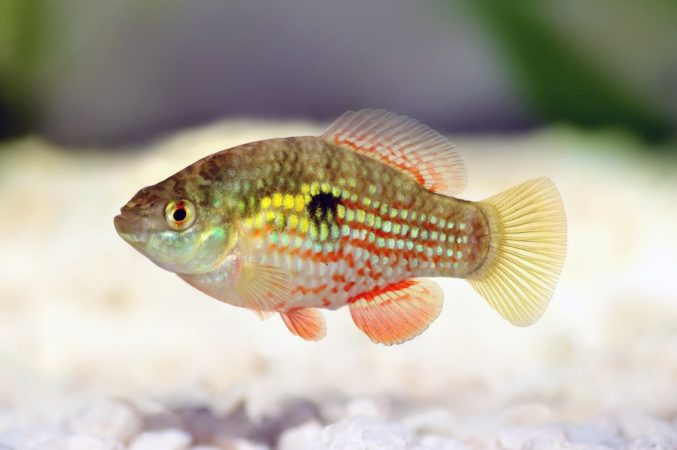
The American Flagfish Killifish have a tranquil demeanor. This makes them an excellent addition to community aquariums. Nevertheless, they don’t match well with all freshwater fish, particularly when you introduce the male ones.
The male ones might occasionally display symptoms of violence if they become territorial. Therefore, ensure that you don’t put more than two male flag fish in one same tank. Instead, arrange them apart from each other so that they can have their own room to swim about.
Furthermore, these species of killififish are quite active and will zoom about the aquarium during the day. Thus, if you want to match them with similarly energetic fish, they have a fantastic time shoaling.
American Flagfish Tank Setup
Requirements
This kind of fish may be raised in both aquariums and ponds. We would advise you to choose the first approach since it allows you to better display their vibrant hues in this manner.
First, it is recommended that various types of plants and flowers should be included in your aquarium’s decor. Make sure to give your fish a sufficient amount of plant-based nutrients, primarily algae.
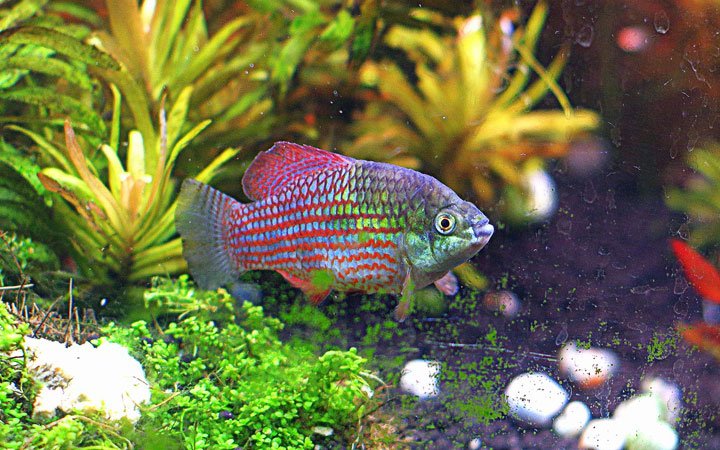
You should consider putting them in a communal aquarium at possible. In addition, providing enough open room for them to swim around. Also, shaded places given by plants, wood, or rocks will keep them from becoming aggressive.
In contrast, if there is little room, they become territorial, which is not desirable in a communal aquarium. Therefore, the ideal tank size for a Flagfish is 15 to 20 gallons, which will keep other fish from bothering him to the point where he becomes territorial.
If you get gravel which is a darker color, your fish will be able to display its true colors in the tank. In certain cases, fish stores may also offer black gravel, which is somewhat more costly but adds an aesthetic element to your aquarium’s design.
Water conditions
The American Flagfish is now considered to be one of the hardiest aquarium fishes available. It has the ability to adapt to a variety of water conditions and settings. This is why we can wholeheartedly suggest this uncommon species to those who are just starting out in the hobby.
Water flow created by filters should be kept to a minimum, as much as is feasible. The reason is that, if the pressure becomes too great, they may get strained.
If you’re concerned about the acidity of your water, you should keep the pH level between 6.5 and 8.5. Because Flagfish is tough fish, the temperature range for this tank is extremely broad, enabling you to vary it between 64 and 85 degrees Fahrenheit without worry.
Installation of a customizable heater and a sponge filter is all that is required to provide optimal water temperature and cleanliness. Sponge filters not only keep a wide range of helpful microorganisms at bay, but they are also simple to clean and reuse time and time again.
A simple approach to alter the water during the week is to use it to water your indoor plants. Using this method, you are constantly eliminating little quantities of water each day. This helps replenish the water tank with new water at any moment.
In any case, replacing the water in the tank on a regular basis is critical for the American Flagfish.
American Flagfish tank mates
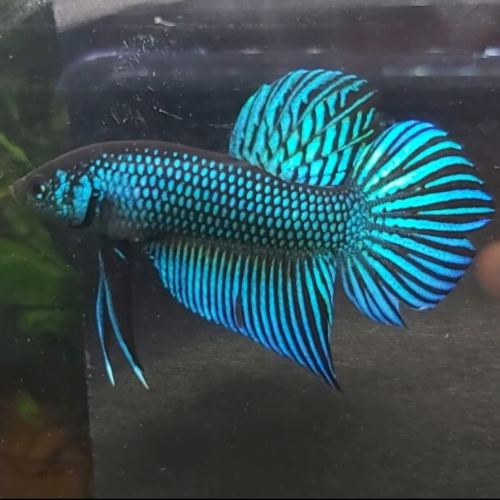
American flagfish are quite simple to care and will thrive in the hands of even the most inexperienced aquarist. It is possible that a paired couple of fish will thrive in a 10-gallon planted tank, but it may be a little too much for more tranquil species. A 20-gallon tank is recommended for keeping additional fish that are more shier and slower-moving than the ones in your 10-gallon aquarium. In a larger tank, you’ll be able to maintain them in groups of six or more, which may brighten up a communal tank while also reducing the amount of algae that grows there.
The American flagfish performs inconsistently in community aquariums; they may become very active, even to the point of biting the fins of slower-moving fish like as guppies or betta species, for example. Maintaining them with fish which can keep up with their pace would be ideal ( for instance, a school of danios or tetras). If you want to keep them alongside other fish that are more placid or slow-moving, you may design an aquascape that allows the other fish to rest and recharge while the flagfish is out of sight.
Glowlight or neon tetra may be your best choice when it comes to color alone. Or, If you want to fish for fish that have outstanding schooling behavior, rummy nose tetras are a good choice since they tend to keep collectively more often than most other schooling fish. As an added benefit, the intensity of their redness may be used as a barometer for aquarium conditions; the more intense their redness, the better the tank condition.
Care
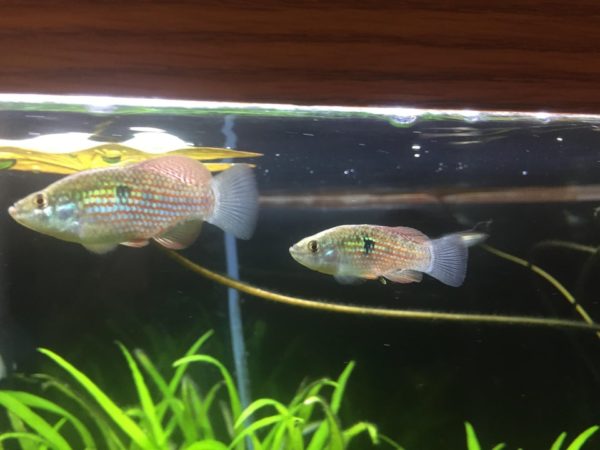
In order for these fish to thrive, the aquarium should be mature and thickly planted with hardy or fast-growing species. The addition of a floating cover to assist absorb the light will also be much welcomed by them. Because American Flagfish are omnivorous, they are likely to consume delicate soft-leaved species as well. When it comes to replicating the natural environment, filtration must be effective but water flow must be mild.
When they are not in spawning mode, American Flagfish are rather quiet, and a large tank with lots of hiding spots should help to minimize any difficulties if they do decide to reproduce. Any aggressiveness at this period is often directed towards conspecifics, but if you give them enough space and provide them with plenty of visible barriers among the decor and plants, it’s really not a problem.
Tankmates should be of comparable size and temperament, and they should be content to dwell in the same colder, somewhat alkaline circumstances as the tankmates. In the aquarium, American Flagfish often browses different forms of algae. If there aren’t much algae available, the diet should be supplemented with enough green foods to satisfy their nutritional requirements while also preventing the fish from nibbling on too many delicate plants.
Feeding
In the wild, American flagfish are omnivores, consuming crustaceans, algae, insects, and plant materials, among other things. In the home aquarium, this diet should be replicated as precisely as possible in the wild. Providing them with high-quality flake food and frequent servings of veggies can help to achieve this. Hikari Tropical Algae Wafers are a great alternative for feeding them since they are high in nutrients. However, please remember that not only is it a high-quality meal, but it also contributes to their diet by providing them with the algae they need.
Also, any live or frozen meals that you can offer would be gratefully accepted. Daphnia, brine shrimp, and blackworms are among the live meals that they like. If there are no live foods available, frozen daphnia, brine shrimp, bloodworms, and blackworms may be provided on a semi-regular basis.
Providing them with vegetables on a regular basis is quite crucial, particularly if there isn’t a lot of hair algae for them to graze on in their aquarium. A few of their preferred veggies include blanched and zucchini or cucumber medallions, shelled peas, blanched, and shelled carrots. Even if you are giving them plants on a routine basis, you should consider feeding them an algae-based meal several times a week as well.
Breeding
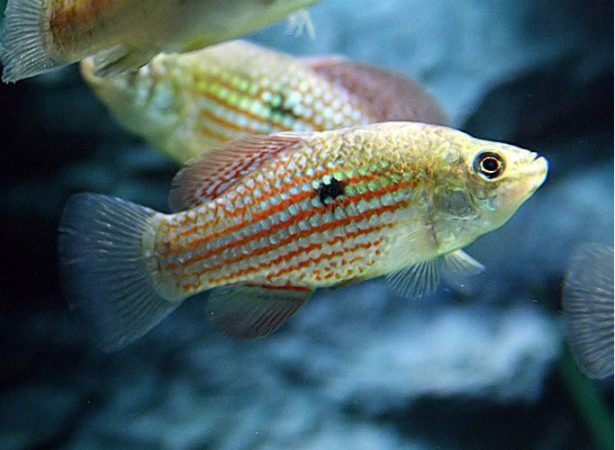
Very modest numbers of fry may occur from time to time in a tank that is thickly vegetated and has plenty of space. When breeding fish, it is recommended that a separate breeding aquarium (at least 24″ long and shallow) be established with comparable conditions to the main tank, with the exception that water temperature should be closer to the top of the desired range.
If you use an air-powered sponge filter to filter the water, it should be very gentle. Also, be sure to supply the breeding aquarium with a fine substrate as well as floating plants to give cover and potential breeding sites. The decoration should be minimal in order to provide the female with a place to hide and relax between spawnings.
Add a well-conditioned couple to the tank and pay close attention; the male may occasionally push the female rather hard, but if she’s not quite ready to spawn, he might cause harm to her reproductive organs. To avoid physical contact between the fish, create a transparent partition between them in the tank so that they may observe each other but not physically approach one another. When the partition can be removed, it will be immediately apparent since the fish will be very interested in one another).
A variety of spawning techniques seem to be used for American Flagfish, with the strategy that is used appearing to be dependent on the way the tank is set up. Not only is the male the one who begins the courting ritual when both fish are ready to spawn, but the female may also trigger this event by performing seductive, quivering dances in front of the other fish. Depending on the level of the water, eggs will be deposited/fertilized either in a depression in the substrate or at the water’s surface, based on the depth of the water.
As previously indicated, a shallower tank seems to be ideal since it appears that the fry needs easy access to the surface throughout the early phases of their growth. More spawning activity is expected to happen over the following several days, with larger batches of eggs being dispersed with each passing cycle of spawning.
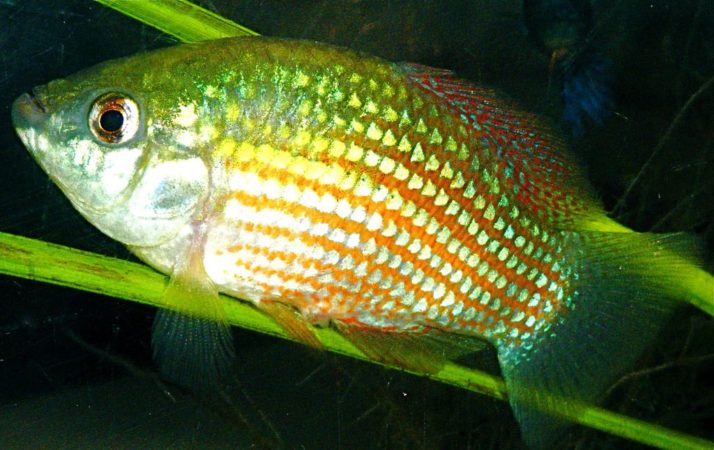
In case the spawning happens on the substrate, the male will protect the eggs against predators by fanning them with his pectoral fins, similar to the way many cichlid species do. It is necessary to remove the female fish from the tank for her own protection if this happens since the male will become quite violent towards her while defending the eggs, and she will already be in a vulnerable condition.
Fish will not take care of their eggs if they are placed in floating plants that have roots that are at the surface of the water. Therefore, when it is clear that spawning has stopped, the fish should be removed from the tank (It will be apparent when one fish suddenly does not respond to an approach by the other).
At this stage, if the male fish is taking care of a clutch of eggs, he should not be removed. At this point, the eggs should hatch in 7-10 days, depending on the temperature of the surrounding water. Many aquarists have reported that if the fries are unable to approach the surface of the water within a short period of time after hatching, they will die in great numbers.
The development of the swimbladder is assumed to be associated with this phenomenon, and it is thus critical to ensure that the small fry will not have to swim too far in order to reach the surface. Green water/infusoria should be provided to them at first, followed by baby brine shrimp and eventually bigger edibles as they get older. Unfortunately, the bigger-sized fry will not hesitate to devour their younger siblings, so if some of the fries are developing faster than others, you may need to segregate the fry by size to avoid this.
Diseases That Affect American Flagfish And Treatments Available
The American Flagfish is very resilient and does not get the usual tank infections that numerous other freshwater fishes are prone to contracting. It is true that they are more susceptible to bacterial or parasite illnesses.
White bumps beneath their skin are an indication of infection and should be treated as soon as possible. Make certain that the sick fish is removed from the tank as immediately to avoid further spread. Also, keep the tank clean on a frequent basis (at least once every two weeks) to limit the likelihood of such diseases in the fish population.
Video: American Flagfish – Jordanella Floridae | Care / Full Information
FAQs
How big does an American Flagfish grow?
Generally speaking, it grows to a maximum length of 2 inches ( about 5.5 cm) in the home tank. The average life expectancy of an American flagfish is two to three years, yet they may survive for as long as five years if they are given extraordinary care and attention.
What is the ideal number of flagfish to keep together?
Typically, they would be stored in pairs, thus a minimum of 20 gallons should be considered as a starting point. This species, on the other hand, flourishes when it is in a community of more than five individuals. In such instances, the tank should be of a substantial size.
What is the recommended feeding frequency for flagfish?
They take pleasure in the algae and floating plants that have been produced in the aquarium. Nonetheless, if your flagfish is kept in a tank with restricted algae bloom, you should provide them with algae supplement pills or algae flakes. Additionally, feed them live meals no more than twice a week in order to keep their protein intake under control.
Is it possible to keep Flagfish alone?
This species is usually best maintained apart from one another. My female American Flagfish performs a respectable job on the algae and then spends the rest of her time bothering the other fish in the group conversation. She isn’t very hostile, but she is assertive enough to make everyone have to get away from her while she is there.
Is the American Flagfish a livebearer?
Flagfish do not give birth to live young, so they are not livebearers. As oviparous animals, they lay their eggs, after which they incubate them and they hatch within a ten-day period.

Annette M. Chaney is an experienced marine biologist with over 20 years of experience as an aquarist and fishkeeper. She started her first aquarium at a young age, filling it with frogs and goldfish obtained from the ten-cent pet store.
Annette grew up caring for and breeding African Cichlids, which led to a hobby in high school that doubled as a profitable means. Attending Reed College gave her time to solidify herself as an accomplished aquarium caretaker with an eye for sales. After that, from 2009 – 2013, she studied at Roger Williams University – one of the most prestigious universities for Aquaculture and Aquarium in USA. She is the founder of AquariumCircle since 2010.
